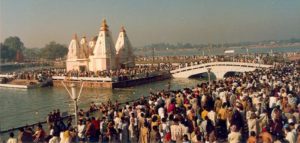By Giriraj Swami
In the first verse of the Bhagavad-gita, the low-minded king Dhrtarastra asks his secretary, “O Sanjaya, after my sons and the sons of Pandu assembled in the place of pilgrimage at Kuruksetra, desiring to fight, what did they do?” Kim akurvata: “What did they do?” Srila Prabhupada says that this is a foolish question. The two armies had gathered to fight, so what is the question of what they did? Srila Prabhupada gives the example that if someone sits down before a plate of food, intending to eat, what is the question of “What did he do?” He would eat—that’s all.
So why did Dhrtarastra ask? Because Kurukshetra is dharma-ksetra, a holy place of pilgrimage. And under the influence of this religious place, his sons might have been influenced toward the good, to give up their intention to fight. Srila Prabhupada explains, “Yuyutsavah. This word yuyutsu [jujutsu] is still used in Japan. Perhaps you know, yuyutsu, fighting. So, yuyutsavah—‘desirous of fighting.’ Now, both parties were desiring to fight, and they assembled. Why is Dhrtarastra asking the question Kim akurvata: ‘What did they do?’? Because he was a little doubtful. These boys, after being assembled in dharma-ksetra, might have changed their ideas. They might have settled up. The sons of Dhrtarastra might have admitted, ‘Yes, Pandavas, you are actually the owners. What is the use of unnecessarily fighting?’ So he was very much anxious whether they had changed their decision. Therefore he is asking.”
Such is the influence of holy places. They can elevate one’s consciousness, even the consciousness of one habituated to low thoughts. And people who go to holy places—Mayapur, Vrindavan, Jagannath Puri—can immediately feel the difference. With reference to the power of living in Mathura-Vrindavan, The Nectar of Devotion explains, “Srila Rupa Gosvami has described Mathura-mandala: ‘I remember the Lord standing by the banks of the Yamuna River, so beautiful amid the kadamba trees, where many birds are chirping in the gardens. And these impressions are always giving me transcendental realization of beauty and bliss.’ This feeling about Mathura-mandala and Vrndavana described by Rupa Gosvami can actually be felt even by nondevotees. The places in the eighty-four-square-mile district of Mathura are so beautifully situated on the banks of the River Yamuna that anyone who goes there will never want to return to this material world. . . . Such transcendental feelings are aroused immediately and without fail after one arrives in Mathura or Vrndavana.” (Chapter 13)
Many pilgrims travel to Vrindavan and other holy places during the month of Kartik, and as they prepare to leave to return to their homes and places of service, they may wonder how they can keep the experience of Vrindavan with them. It is a challenge. The influence of materialistic cities, surcharged with passion and ignorance, can be daunting. And our own busy schedules may leave little time for direct service to Krishna. How can we keep the good influence of the holy places in our lives even after we leave?
Srila Rupa Gosvami advises,
krsnam smaran janam casya
prestham nija-samihitam
tat-tat-katha-ratas casau
kuryad vasam vraje sada
“The devotee should always think of Krsna within himself and should choose a very dear devotee who is a servitor of Krsna in Vrndavana. One should constantly engage in topics about that servitor and his loving relationship with Krsna, and one should live in Vrndavana. If one is physically unable to go to Vrndavana, he should mentally live there.” (Bhakti-rasamrta-sindhu 1.2.294, quoted as Sri Caitanya-caritamrta Madhya 22.161)
We should always engage in remembering and discussing Krishna. His names, forms, qualities, pastimes, and associates in Vrindavan and even our own experiences there. By such engagement, we can experience Vrindavan wherever we are, with Krishna as the focus of our lives.
And we should spread the message of Vrindavan, the message of Mayapur. Once, on a morning walk in Mayapur, a devotee said to Srila Prabhupada, “Mayapur is so nice, I wish I could just stay here,” and Prabhupada responded, “You must go out and make the whole world Mayapur.”
To experience Vrindavan outside Vrindavan is difficult; to create Mayapur outside Mayapur is difficult. But Srila Prabhupada said, “Spiritual life is difficult, but material life is impossible.” So let us make an honest effort to engage in Krishna consciousness, and Krishna and His devotees will surely help us.

Comments